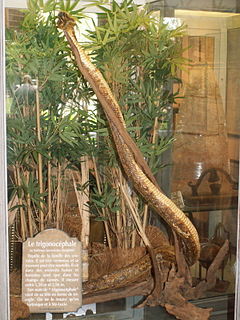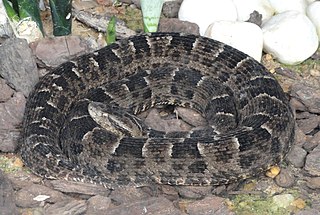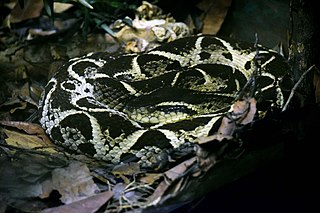
Bothrops atrox — also known as the common lancehead, fer-de-lance, barba amarilla and mapepire balsain — is a highly venomous pit viper species found in the tropical lowlands of northern South America east of the Andes. No subspecies are currently recognized.

Bothrops lanceolatus — known as the fer-de-lance, Martinican pit viper, and Martinique lancehead — is a species of pit viper generally considered endemic to the island of Martinique. No one has satisfactorily explained why it has flourished there but is unknown on nearly all other Caribbean islands. Some reserve the common name fer-de-lance for this species, while others apply that name to other Bothrops species as well. No subspecies are currently recognized.

Bothrops is a genus of pit vipers endemic to Central and South America. The generic name, Bothrops, is derived from the Greek words βόθρος, bothros, meaning "pit", and ώπς, ops, meaning "eye" or "face", together an allusion to the heat-sensitive loreal pit organs. Members of this genus are responsible for more human deaths in the Americas than any other group of venomous snakes. Currently, 45 species are recognized.

Ilha da Queimada Grande, also known as Snake Island, is an island off the coast of Brazil in the Atlantic Ocean. It is administered as part of the municipality of Itanhaém in the State of São Paulo. The island is small in size, only 43 hectares, and has a temperate climate. The island's terrain varies considerably, ranging from bare rock to rainforest. It is the only home of the critically endangered, venomous Bothrops insularis, which has a diet of birds. The snakes became trapped on the island when rising sea levels covered up the land that connected it to the mainland. The ensuing selection pressure allowed the snakes to adapt to their new environment, increasing rapidly in population and rendering the island dangerous to public visitation. Queimada Grande is closed to the public in order to protect both people and the snake population; access is only available to the Brazilian Navy and selected researchers vetted by the Chico Mendes Institute for Biodiversity Conservation, the Brazilian federal conservation unit.

Bothrops asper is a highly venomous pit viper species, ranging in distribution from southern Mexico to northern South America. It is found in a wide range of lowland habitats, often near human habitations. Because of its proximity to human habitations and its defensive temperament, it is more dangerous to people than many other snakes. This species is the main cause of snakebite incidents within its range. No subspecies are currently recognized.

Bothrops leucurus, commonly known as the whitetail lancehead or the Bahia lancehead, is a species of venomous snake, a pit viper in the family Viperidae. The species is endemic to Brazil. There are no subspecies which are recognized as being valid. They can grow up to 170 cm.
Batroxobin, also known as reptilase, is a snake venom enzyme with Venombin A activity produced by Bothrops atrox and Bothrops moojeni, venomous species of pit viper found east of the Andes in South America. It is a hemotoxin which acts as a serine protease similarly to thrombin, and has been the subject of many medical studies as a replacement of thrombin. Different enzymes, isolated from different species of Bothrops, have been called batroxobin, but unless stated otherwise, this article covers the batroxobin produced by B. moojeni, as this is the most studied variety.

Bothrops insularis, commonly known as the golden lancehead, is a highly venomous pit viper species endemic to Ilha da Queimada Grande, off the coast of São Paulo state, in Brazil. The species is named for the light yellowish-brown color of its underside and for its head shape that is characteristic of the genus Bothrops. No subspecies of Bothrops insularis are currently recognized. It is one of the most venomous snakes in Latin America.

Bothrops neuwiedi is a highly venomous pit viper species endemic to South America. This relatively small snake has a wide range and is a major source of snakebite in Argentina. It was named after German naturalist Prince Maximilian of Wied-Neuwied (1782-1867), who made important collections in Brazil (1815-1817). Seven subspecies are currently recognized, including the nominate subspecies described here.

Bothrops oligolepis is a venomous pitviper species found in Peru and Bolivia. The specific name is derived from the Greek words oligo and lepis, meaning "few scales"; probably an allusion to the lower numbers of dorsal and ventral scales that it has compared to B. bilineatus. No subspecies are currently recognized.

Bothrops brazili is a venomous pitviper species endemic to South America. No subspecies are currently recognized.
Calliostoma osbornei, common name Osborn's top shell, is a species of medium-sized sea snail, a marine gastropod mollusc in the family Calliostomatidae, the calliostoma top snails.

Bothrops jararacussu, commonly known in English as the jararacussu, is a highly venomous pit viper species endemic to South America. It's one of the most dreaded snakes in South America and can grow up to 2,20 meters.

Bothrops fonsecai, or Fonseca's lancehead, is a species of venomous snake in the family Viperidae. The species is endemic to Brazil.

Bothrops lutzi, the Cerrado lancehead, is a species of venomous snake in the family Viperidae. The species is endemic to Brazil.

Bothrops moojeni, commonly known in English as the Brazilian lancehead, is a species of venomous snake in the family Viperidae. It is a pit viper endemic to South America.
The fauna of Uruguay is a part of the wildlife of Uruguay.

Naticopsis is an extinct genus of small sea snails belonging to the family Neritopsidae.














